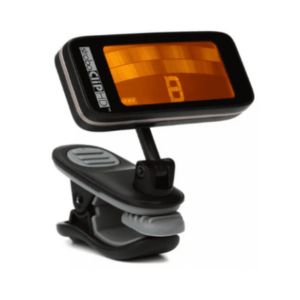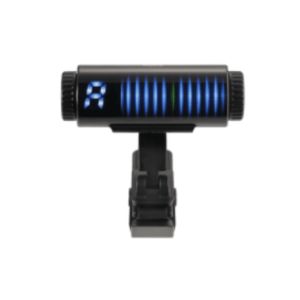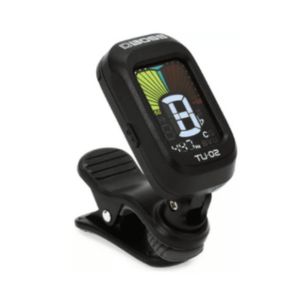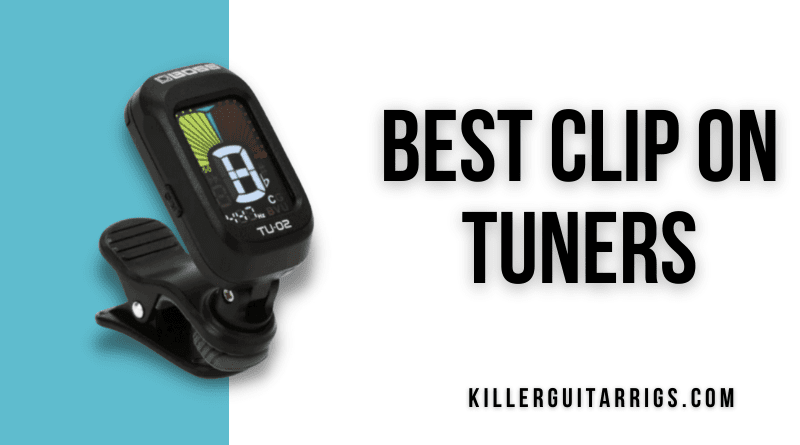No matter how many years you’ve played, how advanced your skillset, or how good a guitar player you are, you won’t sound good if your guitar isn’t in tune. Some players can develop perfect pitch (being able to hear a note and identify it without any tools), but true perfect pitch is rare. Most mere mortals will require some kind of a tuner in order to keep their guitars at the correct pitch.
One of the most convenient types of tuners is the humble clip-on tuner. In this KillerGuitarRigs Guide, we’ll be taking an in-depth look at the 5 Best Clip-on Tuners on the market.
For consistency, we used each clip-on tuner with the same guitar, in this case a Martin 000-X2 Acoustic. We restrung the guitar two days prior to allow ample settling time, but didn’t play it until the test in order to keep the strings fresh.
The test itself was focused on how quickly the tuner registered each note and how accurate the tuner was. For reference notes, we used a calibrated digital piano. In addition, we compared the brightness and clarity of the screen, and the overall build quality.
Read more about our review process.

Peterson StroboClip HD
Features: HD Display, 0.1 Cent accuracy, Soft rubber jaws
Benefits: Easy to read, Pinpoint accuracy, Safe for all finishes

Korg Sledgehammer Pro
Features: Single hand operation, 3 Meter modes, Auto power off
Benefits: Excellent battery life, Easy to operate, Variety of tuning options

Boss TU-02
Features: Color LCD display, Swivel adjustment, 24 Hour battery life
Benefits: Efficient operation, Easy to angle, High visibility in darkness
Contents
Our Top 3
Our Top Pick in this test was the Korg SHCS100 Sledgehammer. It comes from a trusted name in musical electronics, it looks fantastic, and we were overall very pleased with its tuning performance.
Our Best Budget choice is a mainstay in the world of clip-on tuners – the Boss TU-02. This is an inexpensive model that is reliable, affordable, and most importantly accurate.
If you’re not worried about cost, we recommend you check out our Editor’s Pick, the Peterson StroboClip HD. It’s a fast, deadly-accurate tuner, and the build quality is superb. It’s more costly than the others in this list, but it’s absolutely worth the upgrade.
Individual Reviews
Korg Sledgehammer Pro – Our Top Pick

Unique looks and excellent visibility from a renowned brand
Korg is a well-respected brand in the musical electronics space, so we expected a lot from their Sledgehammer Pro. After unpackaging it, we were really struck by how cool it looked. The Korg Sledgehammer Pro has a pretty unique cylindrical shape, which offers so much more than cool aesthetics. The display itself is actually curved, giving it what is effectively a 3D screen. This lets us view it from multiple angles without having to adjust anything.
We found the display to be very clear and bright, without being dazzling. This gave us great visibility both in bright and dark conditions, something guitarists who gig regularly will appreciate.
We found the clip to be very sturdy, and the hinge point had just the right amount of resistance – easy to manipulate, but sturdy enough that it didn’t move around when we were accessing the tuner’s functions. Another nice touch was the included batteries. The only flaw we found was that the battery compartment was a little tricky to get into, but the batteries last so long, you won’t need to change them often anyway.
As for accuracy, we found that it tuned the guitar exactly to match the reference note on the digital piano. It features 0.1 cent accuracy, so we were able to get the pitch dead on. And because it picked up the plucked notes very quickly, we didn’t have to strum continuously to maintain a readout on the display.
Verdict: The Korg Sledgehammer Pro is a great chromatic clip-on tuner. It works for both bass and guitar, and is ideal for the gigging musician and bedroom-only players alike. The design is excellent, allowing single-handed operation while playing, something not every tuner can boast. It has a strobe mode for easy alternative tuning, and we absolutely loved the readability of the display.
Boss TU-02 – Best Budget

The usual Boss Quality, accuracy, and style in a tiny package with a tiny price tag.
Boss are widely recognized for their contribution to the world of pedals and FX. They are also credited with developing two of the world’s best loved tuners, the TU-2 and the TU-3 pedal tuners (you can read more about those in our in-depth comparison here).
The TU-02 just screams Boss. Opening it, we were greeted with the same, familiar quality that we’ve come to expect from all Boss products. This shouldn’t be surprising given the manufacturer, but we were still really floored because of the low price.
The display was crisp and clear, and easily visible in all lighting conditions. The display itself crams a lot of information onto it. Some may find this distracting, but we appreciated having the always-on reference pitch displayed.
Build quality far exceeded anything else in this price range, and actually aligned more with the premium models like the Korg and the Peterson. The spring on the clip was firm without ever feeling like it could damage the headstock. And like the StroboClip, it featured a rubber pad rather than glued-on foam – a nice touch. The 3-way axis adjustment allowed us to get comfortable viewing angles, and we had no trouble in adjusting it.
We found that the TU-02 was reasonably quick to register the notes played, but because of the relatively lower accuracy (+/-1 cent) vs the thousandth of a cent on models like the StroboClip, it did take some time to get to the correct pitch per the reference.
Verdict: We really loved the Boss TU-02. For the money, there’s nothing that really comes close. It’s clearly built to a standard not a price, and yet it was the must budget-friendly tuner on test. It offers chromatic, guitar, bass, and ukulele tuning, so if you’re a multi-instrumentalist, you’ll only need the one tuner. It’s simple to use, and offers great battery life.
Peterson StroboClip HD – Editor’s Pick

There’s a good reason why guitar techs and recording studios around the globe choose Peterson’s Strobe tuners – they’re simply the most accurate tuners on the market. Not only are they incredibly precise, but their reliability and sturdy build quality means they outlast almost everything else out there. Yes, they’re expensive, but a Peterson StroboClip HD will give you years of faithful service.
The KGR team love Peterson rack tuners, so we were really excited to get our hands on the StroboClip HD. It didn’t disappoint. The display was as crisp as we expected it to be – bright enough to be seen in harsh sunlight, yet not dazzling in darker stage conditions.
Build quality was absolutely outstanding. Everything was sturdy, without wobble, and the plastics (where used) feel premium. Instead of cheap foam on the clip, the StroboClip HD features soft rubber, which provides a firmer grip for better vibration transfer and thus more accurate tuning. Not only that, but the rubber coated clamps will almost certainly outlast anything with foam glued onto it.
While simple, the strobing LCD display very quickly got us to pitch. It registered the string we were playing almost immediately and clung onto the sound, meaning less plucking and faster tuning. The display registers to thousandths of a cent, so of course our tuning was exact in comparison to the digital piano reference.
Verdict: The Peterson StroboClip HD is a truly outstanding clip-on tuner. Accuracy is as good as it gets, build quality is peerless, and usability is a real strong point. It’s loaded with over 50 tunings, which will quickly get you to pitch for just about any alternative tuning you can think of. In addition to the basic features, it also has upgradable firmware, so as Peterson introduce new pre-loaded tunings, you can download them to your StroboClip HD.
D’Addario Eclipse

Easy-to-read display and simple operation in a low-cost package.
Chances are if you’ve ever shopped for guitar accessories, you’ve come across D’Addario. This is a brand normally associated with strings, but since their merger with Planet Waves they’ve been responsible for some great electronics, including this neat clip-on tuner.
The Eclipse tuner features a rectangular, vertically-oriented display, which we found to be better than many of the square designs available in the budget end of the range. It provided a really clear view with intelligent use of the available space, which made it easy to tune without squinting to see.
The screen isn’t the brightest that we tested, but we were still able to read the display in sunny, outdoor settings and it was still readable even in complete darkness. It has a 3-axis hinge, rather than a ball-and-socket, so while not quite as maneuverable as some, we were still able to get it to settle at a good angle. And because it was sturdy and well-fitted, it stayed right where we put it.
One gripe about its build quality is that the battery cover is quite easily knocked off, and when that happens, the spring-loaded button battery tends to go flying!
The sharp and flat cent markers are different colors, with the flat indication at the bottom (green) and sharp up top (red). The note that it recognizes is displayed in the middle, and the cent markers disappear when you’re at pitch.
It registered notes fairly quickly, so while we managed to get the guitar in tune, it did take the longest of any of the tuners on test. The instructions don’t actually specify the scale that the cent markers are on, but when we managed to tune up to what it recognized as the correct pitch, we found it to be accurate in comparison with the reference digital piano.
Verdict: A solid performer overall, the D’Addario Eclipse Clip On Tuner did exactly what we needed it to do. It wasn’t quite as fast as some of the more premium examples like the Korg Sledgehammer or the Peterson StroboClip, but it tuned just fine. This is a great “throw it in the gig bag” tuner, and it comes at a price that makes it affordable to replace if it ever gets lost or broken.
Snark Rechargeable Clip-on Tuner

A no-compromise tuner with rechargeable power.
Snark are one of the go-to names in clip-on tuner technology. They make a wide range of models, but if we had to choose one (and we did) to put in this list, it would be the Snark Rechargeable. Lithium ion battery technology has come such a long way, we’re actually surprised that we haven’t seen rechargeable tech become the norm. Until that’s the case, this Snark remains a standout.
We did like that the screen was clear and bright. The display is uncluttered, simply showing the registered note and where you are relative to correct pitch. It made for simple tuning, which is always a plus.
Build quality was good, but not spectacular. Snark have upgraded this model with vulcanized rubber pads, which as we’ve pointed out, really do help to make better contact with the guitar. This makes the tuner more secure and tuning more accurate, but we did find there was some play in the spring. We also noted that the screen was difficult to set at the perfect angle. It was overly stiff, which resulted in us overshooting the right position when setting up. We suspect that this will ease over time, but it’s still something to be aware of.
It offered simple, one-button operation, but didn’t have as many features as some of the other tuners. In fact, this is simply a chromatic tuner. It isn’t pre-loaded with tuners for specific instruments or alternative tunings. This isn’t necessarily a bad thing, as some players just want the simplicity of a chromatic tuner.
The rechargeable battery was something we all loved having. The problem with replaceable battery tuners is they often use button batteries and watch batteries. You can be sure when you need a new one, there will be none to be found. To recharge this Snark, simply plug it into a micro USB charger. Within a couple of hours you have power to last a few weeks.
As far as tuning accuracy went, we did have a little trouble at the bass end of the register. In fact, it had quite some difficulty picking up the low E. We did eventually get it to pitch, but it took a lot of plucking on the 6th string. The other strings did register quickly, however, and all tuned accurately to the reference on the digital piano.
Verdict: The Snark Rechargeable Clip-on Tuner was definitely a favorite with the KGR team. Having a rechargeable tuner you can plug into a laptop, a mobile power bank, or any other USB power source can really get you out of a bind if you find yourself with a dead tuner when you need it most. Despite difficulties at the low end of the register, we still got the guitar to pitch in a reasonable time. If you’re a fan of Snark Tuners, this is one for you to check out!
How to Choose The Right Tuner For You
Clip-on tuners often look pretty much identical to one another, so what exactly is it that separates the best from those you should avoid? Keep on reading to find out.
How Do Clip-on Guitar Tuners Work?
Clip-on guitar tuners work by means of a transducer. When firmly clamped onto your guitar, the transducer detects vibrations. It is these vibrations that indicate the pitch of the string. The biggest benefit of using vibrations to measure pitch is that it isn’t impacted by the volume of the instrument, or the ambient noise in the venue.
For this reason, you can tune an unplugged acoustic guitar in a crowded room in the same time frame as you could in a silent recording booth.
What Other Kinds of Tuners Are There?
There are several other styles of tuner, all with their own pros and cons:
Handheld
Handheld models were among the first digital tuners to hit the market. They’ve been around since the ’70s and work both as a line-in tuner (similar to a pedal), and as a microphonic tuner. They are available as no-frills, straightforward tuners or as feature-laden units with all the bells and whistles. For example, some even have speakers so that they can play a reference pitch for multiple guitarists to tune against at the same time.
Pedal
Pedal tuners are a staple of the pedal board of gigging musicians the world over. They’re durable, reliable, and offer features like bypasses so players can tune up without subjecting their audience to the sounds of pitch correction.
Rack-Mounted
Rack-mounted tuners are the most expensive of all the tuners. They’re not too common amongst amateurs and are usually found in studios. They have huge displays to make it easy to see tuning status from a distance, and often have multiple input and outputs, which helps if they’re being run in a large rig.
App-Based
We absolutely can’t overlook the app-based tuner. Using the microphone of your cellphone or tablet, an app-based tuner works in much the same way as a handheld unit does when in mic mode. The accuracy of these apps varies massively and there’s often no calibration options. So they should generally only be used in a pinch, rather than as a primary tuner.
Why Buy a Clip-on Tuner Over a Pedal or Rack Tuner?
Clip-on tuners have come a long way since they were first invented. Early models struggled with accuracy, but modern examples offer comparable or even better tuning accuracy than rack-mounted or pedal-based tuners.
As well as accuracy, a clip-on tuner won’t impact your guitar’s tone. If you’re running a pedal tuner in your signal chain, you’re potentially diluting your guitar’s signal strength and ultimately impacting tone, without getting anything in return.
In addition to potential tonal benefits, clip-on tuners are smaller, lighter, and in most cases, much cheaper, than pedal tuners, or rack-mounted tuners.
What to Look For
There are a few things to look for when shopping for your next tuner to help you identify the best for your needs:
Accuracy
Tuning accuracy is measured in cents, which are hundredths of a semitone. The most accurate units will measure to thousandths of a cent.
Screen Brightness
When shopping for your tuner, try to find a model that can give you the brightness you need in outdoor settings, but isn’t so bright that you’re dazzled in dark spaces (as this can make it hard to see the fretboard). Some models even feature adjustable brightness.
Build Quality
High quality tuners are made with sturdy springs on their clamps, and preferably coated with a soft-touch rubber. Cheaper models often have high-density foam, but this tends to dampen vibrations, which reduces accuracy. The foam also wears much quicker.
Final Thoughts
We hope this guide to the best clip-on tuners has given you the information you needed to make your choice! In summary, we loved the all-around performance and price blend of the Korg Sledgehammer. It looked great and offered great bass end response. The Boss TU-2 is a tuner that far outperforms its price. It offers tremendous build quality and a great interface. Finally, our favorite was the Peterson StroboClip HD. We loved everything about this tuner, from the clear display to the rapid note recognition and incredible accuracy.
Any of the tuners we’ve recommended here today will absolutely serve you well – so the next question is, which will you buy?


